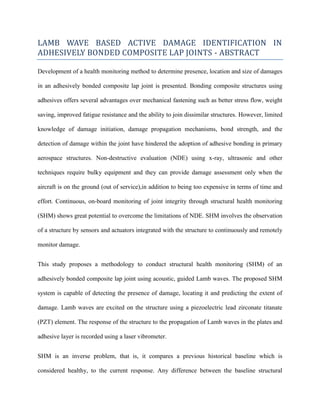master's thesis abstract
This document presents a methodology for conducting structural health monitoring of an adhesively bonded composite lap joint using acoustic guided Lamb waves. The proposed system can detect damage presence, locate damage, and predict extent of damage. Lamb waves are excited using a piezoelectric element and the structure's response is recorded using a laser vibrometer. Damage is identified by comparing the current response to a baseline healthy response. Time of flight analysis is used to generate loci of possible damage locations, and data from multiple sensors is triangulated to locate damage. Finite element modeling is used to study the technique's effectiveness. Experimental validation on composite laminates joined with adhesive accurately locates damage and correlates detected signals with increasing damage size.

Recommended
Recommended
More Related Content
Similar to master's thesis abstract
Similar to master's thesis abstract (20)
master's thesis abstract
- 1. LAMB WAVE BASED ACTIVE DAMAGE IDENTIFICATION IN ADHESIVELY BONDED COMPOSITE LAP JOINTS - ABSTRACT Development of a health monitoring method to determine presence, location and size of damages in an adhesively bonded composite lap joint is presented. Bonding composite structures using adhesives offers several advantages over mechanical fastening such as better stress flow, weight saving, improved fatigue resistance and the ability to join dissimilar structures. However, limited knowledge of damage initiation, damage propagation mechanisms, bond strength, and the detection of damage within the joint have hindered the adoption of adhesive bonding in primary aerospace structures. Non-destructive evaluation (NDE) using x-ray, ultrasonic and other techniques require bulky equipment and they can provide damage assessment only when the aircraft is on the ground (out of service),in addition to being too expensive in terms of time and effort. Continuous, on-board monitoring of joint integrity through structural health monitoring (SHM) shows great potential to overcome the limitations of NDE. SHM involves the observation of a structure by sensors and actuators integrated with the structure to continuously and remotely monitor damage. This study proposes a methodology to conduct structural health monitoring (SHM) of an adhesively bonded composite lap joint using acoustic, guided Lamb waves. The proposed SHM system is capable of detecting the presence of damage, locating it and predicting the extent of damage. Lamb waves are excited on the structure using a piezoelectric lead zirconate titanate (PZT) element. The response of the structure to the propagation of Lamb waves in the plates and adhesive layer is recorded using a laser vibrometer. SHM is an inverse problem, that is, it compares a previous historical baseline which is considered healthy, to the current response. Any difference between the baseline structural
- 2. response and the current structural response is an indication of a change in the material boundaries of the structure, thus indicating damage. The first instance of deviation between the healthy and current responses indicates the total time of flight of the excited Lamb wave from the PZT, to the new damage site and a reflected wave from the damage site back to the vibrometer sensor point. This time of flight evaluation, along with material properties of the laminate is used to create a locus of points along which damage is predicted to lie. The time of flight evaluated at multiple sensor points is used to generate multiple damage loci to triangulate the location of damage. The extent of damage is evaluated by considering the strength of the wave that is transmitted through the joint. A damage index is defined to quantify the extent of attenuation of the signal transmission as damage increases. Finite element modeling of a joint in both 2D and 3D using ABAQUS, a commercially available FEA software, is used to study the effectiveness of the damage triangulation technique. The 2D simulation evaluates Lamb wave propagation in the cross-section of the joint. Plain strain linear quadrilateral elements are used for 2D model of the joint. The dynamic explicit simulations show Lamb waves as they propagate through the structure. The simulation is also capable of evaluating the time of flight of the wave. The 3D simulations are used to test the entire damage triangulation methodology. The plates are modeled using linear quadrilateral shell elements, and the PZT and adhesive layer are modeled using linear 3D stress elements. The dynamic explicit simulation is used to triangulate damage using three sensor points around the PZT. The damage triangulation from the numerical results shows good correlation between the predicted and actual damage locations. Experimental validation of the methodology is conducted on two [0/90/0/90]s composite laminates joined using an epoxy based adhesive. The Lamb wave is mode tuned to provide
- 3. maximum signal-to-noise ratio. Damage is caused in the lap joint using a drop tower. The experimental setup is able to determine time of flights at three sensor locations and thus triangulate damage. The difference between the predicted and actual damage sites is very small (less than 5% of the length of the structure). Experiments also show good reciprocity between the damage index and the number of impacts on the lap joint, thus validating the ability of the methodology to detect an increase in the size of damage.